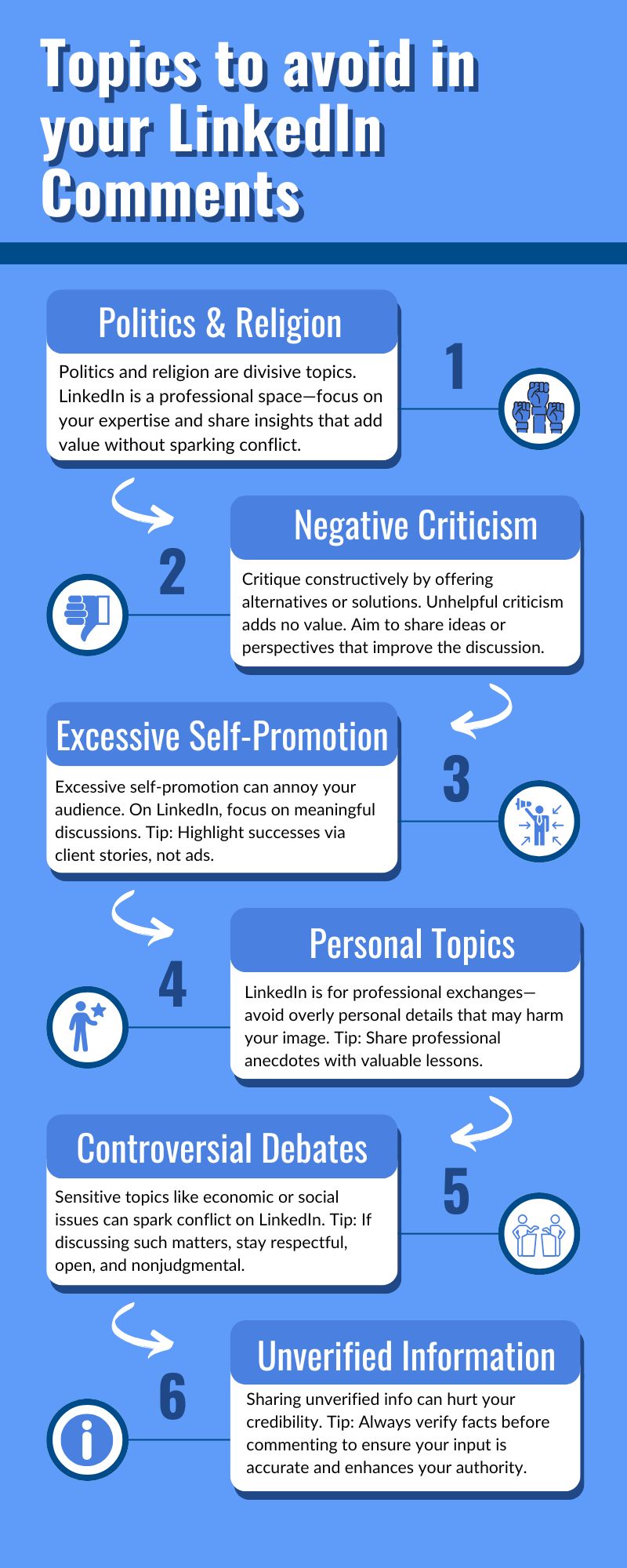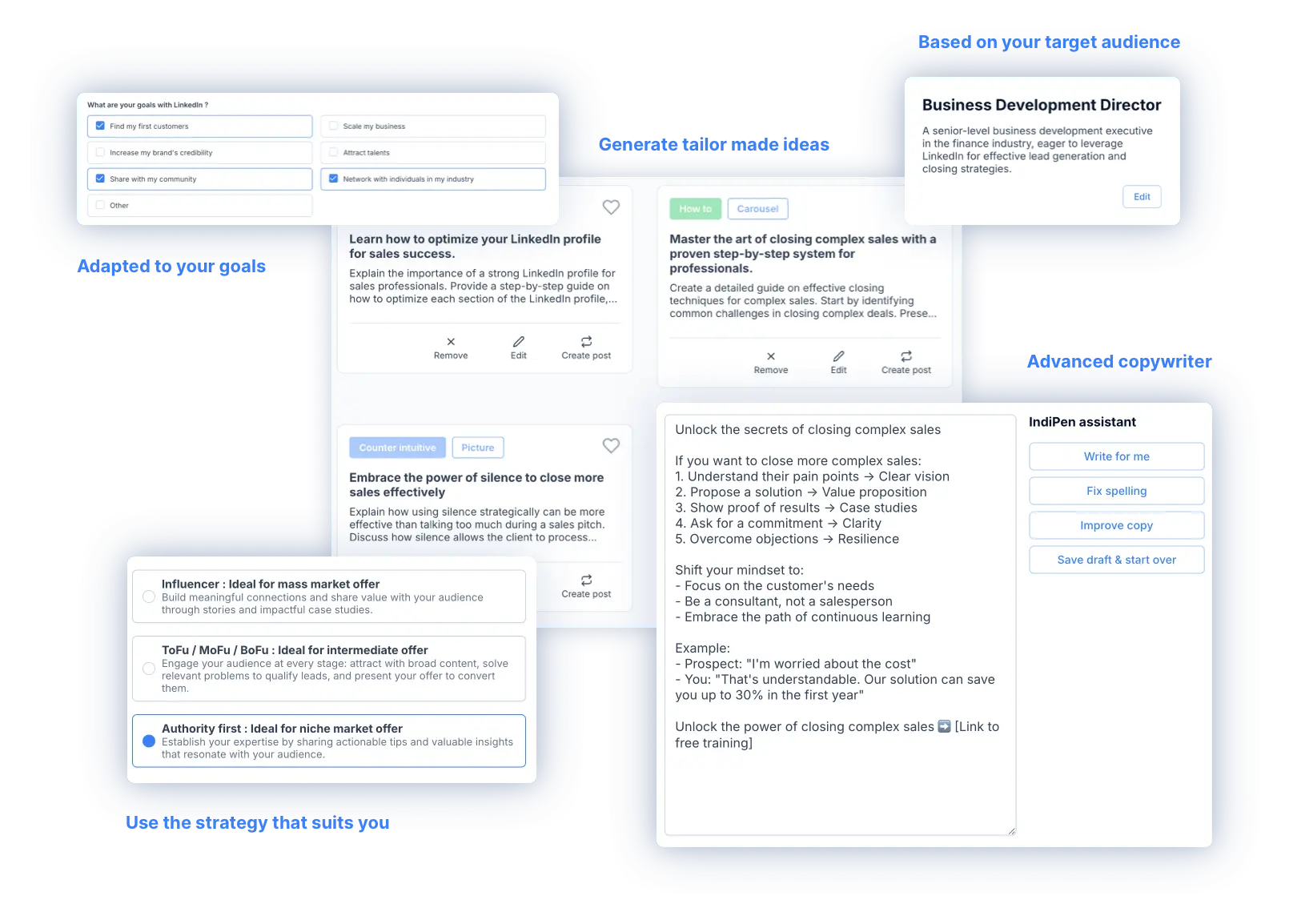6 topics to absolutely avoid in your LinkedIn comments
6 Topics to absolutely avoid in your LinkedIn comments in 2025
Commenting on LinkedIn posts can be a real growth lever for your business.
It can significantly boost your profile views and impressions, as explained in this study by LinkedIn expert Mark Firth on Liseller.com.
Often, your prospects, clients, and partners see your comments—even if they don’t interact with them.
Your comments can skyrocket your visibility and attract clients, but they can also harm your reputation if you make certain mistakes.
Here are 6 mistakes to avoid to maintain your professional image online.
1. Politics & religion
Political and religious discussions on LinkedIn can quickly divide people…
According to their 2022 study titled “Politics at Work Study,” 20% of American workers reported being mistreated at work due to their political opinions.
You’re free to talk about it, but more often than not, you stand to lose more than you gain.
Recommended alternative:
Focus on topics related to your industry, news, or trends.
It showcases your expertise without risking polarizing your audience.
Concrete example:
Instead of commenting:
“This economic policy is a disaster.”
Prefer:
“The new regulations are impacting our sector. Here’s my analysis of the upcoming challenges…“
2. Destructive criticism
Criticism without constructive suggestions can hurt your image. Try not to get carried away and keep your emotions in check.
Replacing destructive criticism with constructive feedback is the best move, and it can even boost your visibility.
Additionally, a Gallup study found that 80% of employees who received constructive feedback in the previous week are fully engaged in their work.
Recommended approach:
Use the “sandwich” method: start with a positive point, then offer a suggestion for improvement, and end with encouragement.
Concrete example:
Instead of saying:
“This project is poorly designed.”
Prefer:
“The project has solid foundations. Maybe we could improve [specific aspect] to make it even more effective?“
3. Excessive self-promotion
Comments that constantly promote your services can quickly tire your audience and damage your image. LinkedIn’s algorithm favors authentic interactions.
According to a SEO Sandwitch study, personal stories generate 40% more engagement than purely promotional content.
Recommended approach:
Focus on experience sharing, anonymized case studies, or practical tips without directly mentioning what you offer.
Follow the 80/20 rule: 80% added value content, max 20% subtle promotion.
Concrete example:
Instead of saying:
“We offer this solution at [Company]”
Prefer:
“In my experience, this approach led to a 30% improvement in results”
Note: Even without self-promotion, a well-optimized LinkedIn profile with a clear headline and relevant keywords helps prospects discover you in their feed.
4. Personal life details
Overly personal content can harm your professional image. LinkedIn values authenticity—but within a professional framework.
The right balance is sharing human experiences that offer a useful lesson to your community.
Recommended approach:
Start from a real-life situation, draw a clear takeaway, and link it to your field or activity.
Concrete example:
Instead of saying:
“I’ve been going through a really tough personal time.”
Prefer:
“After a tough setback, I learned to better prioritize and delegate. As a result, I doubled my results in 3 months.”
5. Sensitive topics & debates
Discussing controversial topics (discrimination, social conflict, generational debates…) can quickly divide your audience. Taking too strong a stance can hurt your credibility or cause backlash.
However, staying silent on certain important topics can also make you seem out of touch. It’s all about tone, posture, and timing.
According to the Edelman Trust Barometer 2024, 71% of consumers believe brands should take a stand on key societal issues, as long as that stance is authentic and responsible.
Recommended approach:
Acknowledge the topic’s complexity, keep a factual tone, and guide your message toward actionable or reflective takeaways for your audience.
Concrete example:
Instead of saying:
“Young people don’t want to work anymore—it’s a lost generation.”
Prefer:
“With evolving career expectations among younger professionals, we’ve had to adapt our management styles. The result: better engagement and lower turnover.”
6. Unverified information
Sharing info without checking it can destroy your credibility, even if your intentions were good. On LinkedIn, where expertise is king, even small mistakes can be costly.
According to a Reuters Institute study, 56% of professionals lose trust in a post as soon as a piece of information is proven inaccurate, even if it’s corrected afterward.
Recommended approach:
Before posting or commenting on news, always check your sources. Cross-reference with at least two reliable sources, and cite them to strengthen your authority.
Concrete example:
Instead of saying:
“AI will eliminate 80% of jobs in 5 years.”
Prefer:
“According to a study by MIT, some jobs will be impacted by AI, but most will evolve rather than disappear.”

How to optimize your LinkedIn comments for 2025
The 3 golden rules:
- Value first: Make sure every comment brings useful information or valuable insights to your audience.
- Authentic engagement: Encourage meaningful conversation by asking open-ended questions.
- Professional consistency: Your comments should always reinforce your image as an expert in your field.
Pre-post checklist:
✅ Is the tone appropriate for LinkedIn?
✅ Does this comment showcase my expertise?
✅ Have I verified the accuracy of the shared info?
✅ Does it truly add value to the conversation?
Conclusion: Your LinkedIn reputation is built one comment at a Time
Remember, every comment you publish is an opportunity to earn your network’s trust. Be strategic, authentic, and relevant.
To take your strategy further, discover the mistakes to avoid in LinkedIn comments here,
explore 10 approaches for turning comments into leads here,
and understand why commenting on LinkedIn is key to visibility in this article.
Finally, learn how to properly engage with content creators thanks to this practical guide here.
Ready to turn your LinkedIn profile into a Lead Machine ?
IndiPen helps you define your strategy, find content idea and write engaging content to generate leads with ease
Book a demo
